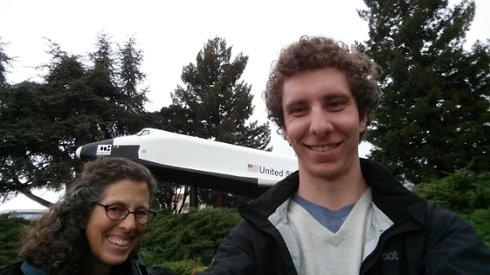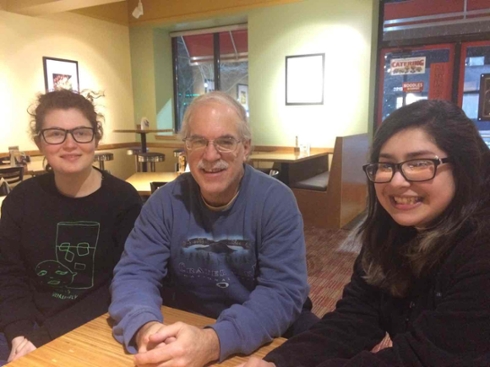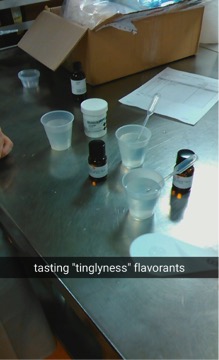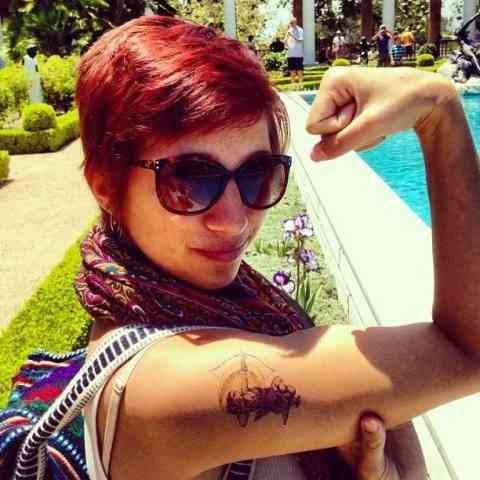Tags
"science"
NASA Ames Research Center: Evan Peairs, Winter Shadow 2016

For two days last winter I had the wonderful opportunity to shadow Arwen Dave, a systems engineer at the NASA Ames research center. I was really excited to get to spend time at Ames - having grown up in the area, I'd often passed by their gigantic wind tunnel and wondered what awesome science was at work inside. NASA Ames is different from other NASA labs in that very little of their work is actual rocket science. A lot of their work involves designing, building, and operating the missions that the rockets actually deliver. Ames has a focus on robotics research, which is the field I'm currently trying to work my way into.
This opportunity came at a critical time in my search for career paths, as I had decided to put off grad school in order to try out future job paths before committing to one in particular. My main decision for which I was gathering information was whether continuing on in academia or shifting to an industry such as engineering would put me on a better career path. Ames was the perfect place to learn about future jobs, as there is a healthy mix of scientists and engineers working in close collaboration.
My time at NASA was split between following Arwen around on her job, taking tours of some of the labs, and wandering around talking to people about their jobs. I finally got to see the inside of a wind tunnel, and got to geek out with the local machinist over their awesome equipment. Following Arwen was very informative in that, for the first time, I got to see what it is that systems engineers do with their time. It turns out that the majority of the work consists of collaborating with lots of different kinds of people to try and get a project designed and built. Working at NASA in particular seems to make the job harder, since there's tons of added bureaucracy to deal with, but also a whole lot more rewarding, since you get to see your creations put into space. Arwen tends to be working on a number of different projects at once, and had a few tips for me on how to seek out and create new work opportunities within an existing position.
Continue reading NASA Ames Research Center: Evan Peairs, Winter Shadow 2016
Astronomy at the University of Michigan: Lizzy Arellano, Winter Shadow 2016

Going to dinner
The winter shadow that I had the pleasure of going to was far more fulfilling than I ever thought it could be. My hosts were very kind. Their homes were beautiful and their hospitality was very much appreciated. Ann Arbor, Michigan, was one of the most beautiful and easy to get around towns that I’ve ever visited. Mario Mateo’s house was about 2 miles from the University of Michigan, where Sarah and I worked most of the time. We found ourselves really looking forward to the walks every day. Not only was it really nice to pass through the urban and suburban areas of Ann Arbor, but it also gave us an opportunity to explore the downtown more. The food was delicious, the sights were see-worthy, and the snow was puffy. I feel so grateful to have received this externship because I will have otherwise never been able to visit Michigan.
As for the actual project, it was a great experience overall. Not only did I learn a lot of Python, a coding language, but also, I gained experience as an intern. I learned about the actual process of working with a data set and getting real results from my work that could actually contribute to scientific process. Because we were using data from the Magellan Clay Telescope in Chile, where each fiber attached to a plate referred to a specific star in the star cluster, Omega Centauri, we were working off Mateo’s idea of a new way of star cluster analysis. We had to be very careful with our calculations, checking and rechecking for the expected results. We had to generalize our coding, so that when new data comes in, it could be analyzed using the same programs and so that people all over the world would have the opportunity to do the same type of analysis. At the end of our externship, our work rewarded us with a complete spectrum of the stars we analyzed, which allowed Mateo to analyze the spectral lines for different elements contained in the stars.
Saturday Academy: Orion Cohen, Winter Shadow 2016
It is difficult to articulate exactly how I imagined non-profits before my time at Saturday Academy. My mental image resembled the bureaucratic equivalent of a panda, accepting donor funds, holding events, and slowly ambling towards its goal of benefiting the greater good. At Saturday Academy I quickly learned that whatever my conception was, it was utterly and completely incorrect. A non-profit is more like a spider in the center of a vast and intricate web of connections. It interfaces with donors, volunteers, and consumers to harness the latent desire of a community to improve itself and manifest that desire into a powerful force for good. Saturday Academy gives thousands of curious students the opportunity to indulge their interest in science with the help of talented community professionals. On a weekly basis, Saturday Academy accomplishes the incredible logistical feat of organizing hundreds of students and teachers into multiple locations across the city. When I asked Jeri Janowsky, Saturday Academy’s director and one of the most capable people I have ever met, how this was done, she jokingly told me, “complete chaos.” My time at Saturday Academy gave me enormous respect for both the mission and staff of the organization.
Additionally, I gained an understanding of the organization and operation of non-profits through a series of semi-independent projects assigned by the staff. Rather than merely observe the organization, I contributed to it, which was rewarding and educational. My observation of Saturday Academy’s structure taught me the most important lesson of all, the necessity of networking. I discovered that what I had negatively conceived of as schmoozing is in fact of a critical part of individual and organizational success.
It would be difficult to envision a more positive externship experience than the time I spent at Saturday Academy. I am incredibly grateful for the opportunity to work at Saturday Academy and honored that I was chosen as extern. I am also thankful for the hard work of The Center for Life Beyond Reed that facilitated the experience.
Continue reading Saturday Academy: Orion Cohen, Winter Shadow 2016
Astronomy at the University of Michigan: Sarah Racz, Winter Shadow 2016

The first thing I did when I found out I was accepted for the Winter Shadow program in Astronomy at the University of Michigan Ann Arbor was look into getting a parka. I was excited to visit Ann Arbor for the first time, and really hoping for some snow.
I stayed in Ann Arbor for a week, and left with unending love for what has become my favorite diner of all time.
I worked with a Mario Mateo, who is an astronomer at the University of Michigan. The project I worked on sought to measure the dependence of the magnitudes of RR Lyrae stars upon metal abundance. RR Lyrae stars are variable stars, known for having short periods. All the stars we observed were from the globular cluster Omega Centauri, which is a cluster known for having a range in the metallicities of its stars. All the data was from a telescope in La Serena, Chile that Mario had built. During the week I wrote several scripts in Python to read from huge files of data and run data analysis.
CCD Innovation Food and Beverage Science: Nicholas Egan, Winter Shadow 2016

The setup for our tasting experiment
I had not, in my life, expected to be able to point at a bottle of salad dressing at Safeway and say, “Oh cool, I made that.”
(‘Helped make that’ is definitely more proper, but sometimes you’ve just got to flex in the grocery store.)
Applying to CCD Innovation to understand the world of food innovation seemed, in my head, to suppose a certain scientific environment: one comprised of vast numbers of tiny bottles filled with hyper-concentrated-who-knows-what in ultra-sterile laboratories, logbooks filled to the brim with the anguish of hundreds of statisticians in the pursuit of ultimate flavor, and a grim, if regulated, corporate environment with masters of the tastebud denoting the desires of the mass public to lesser, flavoring-affiliated chemists.
Lumnicenter Lighting, Brazil: Nate MacFadden, Winter Shadow 2016

In January of 2016 I traveled to Curitiba, Brazil, for a winter shadow at Lumicenter Lighting, an LED lighting company. Immediately after leaving Boston on my plane to Brazil, I felt a mixture and excitement and anxiety: I did not speak Portuguese, had never been to South America, and was going to be doing some challenging engineering. However, as I met my host family I learned that my nerves were for naught. The family I stayed with was warm and inviting. They gave me some of the best home cooking I've had (somehow making healthy food taste really good), and showed me around like I was one of their close friends. They took me to beautiful parks, cities by the coast, drove by the tropical rain forest, went to excellent restaurants, and went go-carting. The most memorable meal for me there was at a churrascaria restaurant. It is a type of all-you-can-eat barbeque with every preparation of beef and pork you could want. I generally graze on food, eating many meals but always small in portions, but here I rarely said no when offered a cut of meat.
Once at the actual company, I was greeted by staff members with whom, once we learned how to get over the language barrier, we immediately started having fun and teasing each other, all while working on a better heating solution for a LED driver. The heat had to be reduced because the higher temperature an electrical component is, the shorter its lifetime. Even if the component is within its safe operating temperature range, being near the top of that range causes the product to break significantly earlier. Many methods were already tested so I had the challenge of coming up with new methods to hopefully be applied either in conjunction with the previous methods or by themselves. The staff made sure to give me feedback on my ideas and helped me every step of the prototyping way. They also knew that nobody could work on an empty stomach, so they introduced me to a snack called Paçoquita which I ended up loving. It was basically crushed nuts and sugar pressed into little cylinders and it was fantastic.
I'm going to miss everything from my trip: the people, the food, the weather, the work... I'll be sure to visit again soon.
Continue reading Lumnicenter Lighting, Brazil: Nate MacFadden, Winter Shadow 2016
ASTRON Institute: Irene Globus-Harris, Winter Fellowship for International Travel

Westerbork
Irene Globus-Harris, sophomore physics major and recipient of the Winter Fellowship for International Travel, reflects on her time in Dwingeloo, the Netherlands, at ASTRON, the Netherlands Institute for Radio Astronomy.
++++++++++++++
The Dutch national color is orange. Bright orange, the type that hurts your eyes after staring at it too long. As I flew in at the break of dawn, the entire sky—awash in an intense, orange sunrise—seemed to reflect that fact. I spent the first few days visiting my host family and friends in North Holland, then headed to Dwingeloo to begin my work at ASTRON. Dwingeloo is small—more of a village than a town, and is adjacent to one of the Netherlands’ largest national parks, the Dwingelderveld. ASTRON itself sits within that national park which made the bike ride in exceptionally beautiful.
Presidents Summer Fellowship, Nanofluids and Gene Mapping Part 3, Abrar Abidi

For his President's Summer Fellowship, Abrar Abidi ’16, physics major is working in a lab at McGill University in Canada, helping to develop new nanofluid technology to improve DNA mapping methods. Read on for his third and final blog installment:
Since leaving Montreal at the end of August, I’ve thought back many times to that day I walked through the old city and down to the port. There, in the Fleuve Saint-Laurent, which flows down to the Great Lakes, lies the small Île Sainte-Hélène. And on the other side of this island, half-concealed by a line of trees, is a structure that looks like it came from another planet. Two hundred feet high, and webbed with steel beams and acrylic panels in the shape of a globe, this exotic building disorients anyone that sees it. It is, of course, the Montreal Biosphere, built a half-century ago by Buckminster Fuller for Expo 67, the most successful world’s fair of the 20th century. In its time, when so many countries were riven by wars and paranoia, Expo 67 offered the world a brief remove from the painful past and shameful present—it offered what the world most craved: an optimistic vision for the future.
My grandfather, who died three years ago, was among the 50 million people who attended Expo 67. The son of a radio repairman in India, he grew up in modest circumstances and struggled to secure himself an education at the only university for Muslims in India. He rose, quickly, to the top of his class, and won a scholarship to come to the US where he began graduate studies in civil engineering at Harvard. Soon after his degree my grandfather returned to what was by then Pakistan, where six of his ten siblings shared two small, adjacent rooms. He worked intensely so he could support and provide a good education to his brothers and sisters. That generation of the Abidi family, though small in number now, all went on to find success in their individual careers, and passed on my grandfather’s tradition of hard work and education to the Abidis of my parents’ generation.
Presidents Summer Fellowship, Nanofluids and Gene Mapping Part 2, Abrar Abidi

For his President's Summer Fellowship, Abrar Abidi ’16, physics major is working in a lab at McGill University in Canada, helping to develop new nanofluid technology to improve DNA mapping methods. Read on for his second blog installment:
On so many warm summer evenings here, red and white flares shoot up on the horizon, hissing as they go, before exploding with a deafening pop, forming a lavish spectacle in the Montreal sky. Often as I sit in my little Victorian-era apartment, sudden bangs and crackles send me rushing out to the roof of my building, so I can look toward the harbor, where on an otherwise forlorn stretch of land, six thousand rockets now fire heavenward in a single night. Yearly, the largest firework festival in the world—a kind of pyrotechnic Olympics—takes place in Montreal throughout the month of July. Groups from countries across the world, with their eyes set on prestigious awards, collect in this city to show off their talents in front of three million people. This year, England won the gold medal, while France took home silver and China, bronze. All this amid a procession of other festivities celebrating jazz and African cultures and circus arts and film and comedy. On the few nights not occupied by these events (and we’re still talking only of July), there are huge live music shows, free to the public, many taking place a two-minute walk from my front door.
The lab is a far quieter and colder place. With vents constantly blowing dry, chilly air on every floor of the building, I’ve taken to swaddling myself in at least three layers. Fortunately, the work I do expunges all my guilt for staying indoors. The opportunity to participate in this lab’s experimental efforts is what lured me to McGill in the first place, and in the previous month, my project has taken on a more experimental flavor. Sara, a good friend and researcher with whom I’ve been working closely since June, gave me the task of analyzing thousands of fluorescence microscopy images, zoomed in so close that a fraction of the width of a single human hair could easily eclipse the viewfinder. Fluorescence microscopy is a remarkable technique, where special dyes are used to stain the object of interest, causing it, when illuminated by a powerful lamp, to cast a vivid, luminous glow, no less dazzling to the eyes than the firework displays I can sometimes see from the lab window. Our microscopes are trained on minuscule nano-devices that Sara very cleverly designed and fabricated. Below the glass cover slip, and within these tiny devices, anywhere from a few dozen to several hundred strands of DNA can be seen drifting here and there, tossed about by Brownian motion, flashing like fireflies in the night. Then, with the flip of a switch, the strands rush toward the centers of a series of equidistant spaces, where they accumulate and extend, resembling a phalanx poised for battle. A dial that controls the frequency of a current sent through the device can manipulate their movement, alternately dispersing and concentrating the DNA. The potential applications for this invention are dizzyingly exciting: nothing less than the technology future generations might use to map entire genomes, at speeds and with accuracies far beyond anything currently possible.
Financial Services Fellowship, 2015: Morgan Vague
"The Financial Services Fellowship is a prestigious award that gives students who are interested in financial services a hands-on experience through an intensive trip to New York City during spring break. Students will meet with people representing a wide range of roles in this industry, including journalists, sales and trading analysts, investment professionals, hedge fund managers, financial analysts and more. All expenses are paid through the generosity of a Reed trustee"
Read on to learn about the experience of Morgan Vague, a science major in the world of finance.
This March, a group of eight Reedies including myself, received the opportunity to travel to the mecca of finance, the big apple itself: New York City. I would be lying if I said I wasn’t nervous during the first night, when our generous trip leader initiated an open questions and answer session about finance over a steak dinner in an iconic New York restaurant. Finance had always interested me, and I could hold a decent conversation about it. But, as the only science major among a group dominated by economics majors, I felt a little out of place. When it was my turn to ask a question, I inhaled deeply, and spouted off a fairly basic question that was answered without the slightest trace of condescension. This set the tone for the next 4 days.
Continue reading Financial Services Fellowship, 2015: Morgan Vague
The Problem of Women in Tech
Michelle Drumm, class of '95, wrote an engaging article on women's involvement (or more accurately, lack of involvement) in technology. Read her article here: http://www.commercekitchen.com/2014/02/women-in-tech/
Michelle is the moderator of Women in Tech at Reed's Working Weekend 2014.
Continue reading The Problem of Women in Tech
"Not just there to teach science": Bailey Boatsman on her experience with Biology Outreach

Bailey Boatsman, Class of 2016
Biology Outreach Lead Teacher
Bailey is a volunteer lead teacher with the Biology Outreach program. The Biology Outreach program creates partnerships with local schools to provide science lessons to students who would not otherwise have access. Although not pursuing the sciences in her own academics, Bailey cultivates her love of teaching and evident reverence for all learning by bringing science to local elementary school students. Her thoughtful perspective reminds us not to forget that enthusiasm and true curiosity are all that is needed to reveal the joy and discovery in life’s smallest moments.
